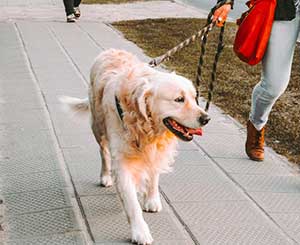There's nothing better than spending a day soaking up the sun with your canine companion! Most dog owners are quick to jump at the chance to relish in the easy-going summer vibes with their pup in tow.
Whether it's a day at the beach, a relaxed walk around the neighborhood, or a picnic at the park, you'd be hard-pressed to find any dog that resists the fun.
But are you doing enough to keep your dog safe from the blistering heat?

Dogs are pretty adaptable and are fully capable of living in a wide range of environments. However, they don't handle prolonged exposure to high temperatures very well.
Dogs of any breed will react negatively to excessive heat. We've all heard about the dangers of leaving dogs in a hot car for more than a few minutes.
Yet, most don't realize that it doesn't take those extremes for dogs to start feeling the heat!
Issues can arise from even brief walks and potty breaks. From physical burns to full-blown heatstroke, hot weather can be dangerous for your furry friend.
As an owner, you must consider how the heat affects your pooch and plan those outings accordingly. So, what temperature is "too hot" anyways?
Ideal Walking Temperatures
There's no "one-size-fits-all" temperature that dogs prefer. Like humans, personal preference and body composition come into play!
Some dogs prefer the icy temperatures due to a thick fur coat that offers ample insulation. Meanwhile, others start to shiver the moment the AC kicks into gear!
What's suitable for your dog will depend on many factors, including breed.
Larger breeds tend to have a lower tolerance to heat than smaller ones. The same goes for pups with double coats and long, thick hair.
It's important to keep those factors in mind when considering how the weather outside will impact your dog's comfort.
Despite the variances, most veterinarians will agree that most canines are the coziest in moderate climates.
Temperatures between 53 and 59 degrees Fahrenheit seem to be the sweet spot. In this small window, the weather is safe and enjoyable for all breeds.
It's cool enough to prevent quick overheating for large dogs and warm enough to stop the shivers in smaller ones.
Generally, you can leave your dog outside for as long as they want in this temperature range! Of course, keep an eye on them to spot any signs of discomfort just in case.
When Heat Becomes an Issue
Now that you know what the "perfect" temperature range is for walks, at what point do things get uncomfortable? As we discussed earlier, the exact threshold is going to vary from one dog to the next.
Every canine experiences temperature variations a little differently. What might not be a big deal for some could be downright uncomfortable for others.
As a general rule of thumb, you should start paying attention to your dog's comfort and well-being once temperatures rise beyond 68 degrees.
Larger dog breeds are most susceptible to issues as the temperature climbs above 70 degrees. The effects aren't instant.

You can still take walks when the weather is slightly warmer than the ideal temperature range. But, time is a significant factor to keep in mind.
The heat will continue to bear down on your dog, increasing the risks of health problems with each passing minute.
As the temperature rises to about 75 to 77 degrees, it can take even less time for heat stroke to set in.
At about 75.2 degrees Fahrenheit, more vulnerable dogs can suffer after only a few minutes.
You might notice puppies, senior dogs, obese dogs, and flat-faced breeds having trouble the most. Things get only significantly riskier as the temperature rises above that 75-degree mark.
What's considered the danger zone for high temperatures? The most commonly accepted threshold is about 89 degrees Fahrenheit.
At that point, the temperature becomes too hot for most dogs to handle for more than a few minutes.
Not only can weather at that temperature lead to heatstroke, but ground surfaces can lead to instant burns.
How Dogs Respond to Hot Weather
The average body temperature for dogs is between 101 and 102.5 degrees Fahrenheit. When exposed to excessive heat, internal temperatures can quickly rise to dangerous levels.
At about 103 degrees, the effects of heatstroke start to rear their ugly heads.
Dogs do not have the same cooling mechanisms that humans do. We have the luxury of sweat glands all over our bodies to cool us down and mitigate extreme temperatures.
Dogs aren't so lucky.
They have some sweat glands on the paw pads and nose, but it's not enough to do any heavy lifting as far as cooling goes. As a result, dogs have to resort to other means.
The most effective technique canines have to lower body temperature is panting. That's why you see your pooch breathing heavily after an intense run or play session.
Panting lets your dog take in large volumes of cool air in a short period of time. This exchange of gasses helps to keep body temperatures at a much safer level.
All that said, panting can only do so much! Dogs will also turn to water for effective cooling. If a bowl of cold water is available, they'll lap as much of it up as possible.
If there's a way to cover the entire body in cooler water, they'll do that, too! Whether it's a pool they can jump into or a massive puddle of mud to wallow through, dogs will take full advantage of it.
You can also use those methods to cool your dog down if heatstroke is imminent. Spraying your dog with the hose and providing plenty of cool water is a must.
Potential Dangers
Hot weather is not something you can ignore or gloss over. All dogs have to go outside at some point, but managing when and how they do it is paramount.

It doesn't take long for heatstroke to occur in hot weather. When this happens, your dog's internal body temperature rises beyond a healthy threshold.
Your pup may start to exhibit peculiar symptoms. If you ignore the signs of heatstroke, it can lead to life-changing health problems or even death!
The first symptom to occur is panting. Panting is pretty standard for dogs, so most owners don't give it a second thought. However, it's essential to pay attention and bring your dog in as soon as they start to pant heavily.
Provide water and crank up the air conditioning inside to ensure that your dog's body temperature goes back to normal.
Other signs of heatstroke include dark red gums, thick salivation, and noticeable lethargy. In extreme cases, dogs often show signs of disorientation.
You might see your pup stumbling around in a confused manner, which indicates a severe problem.
Act fast if you suspect that heatstroke is taking its toll. Remember: Some dogs react negatively to heat much sooner than others. It doesn't have to be anywhere near 89 degrees Fahrenheit for a dog to start suffering.
Pay attention to the signs and take action to ensure that your dog doesn't experience any lasting issues.
Tips for Walking Dogs in Hot Weather
The blazing sun can turn your regular walks into a risky endeavor for your dog. That said, you don't have to keep your pup locked up inside all day. Dogs need some outdoor time to get exercise and do their business.
So how do you keep them safe? Here are some tips to ensure that hot weather doesn't cause any trouble for your dog.
Schedule Walks at Cooler Times
Here's a simple tip anyone can adopt. Instead of going outside when the sun is at its most unforgiving position, plan your walks accordingly.
Even in the dead of summer, temperatures are considerably cooler in the morning and late evening. Take advantage of those times of solace!
Avoid midday walks as much as possible. Temperatures are highest when the sun is directly overhead, so aim for dawn and dusk.
Do the Five Second Test
Ever heard of the Five Second Test? It's a quick and easy way to ensure that your dog won't suffer during your walk.
Place the back of your hand directly onto the ground and hold it there for five seconds. If it's too hot for you to handle, it's far too dangerous for your dog.
Your pup's paw pads offer some degree of protection, but they're not indestructible. Hot sidewalks can cause debilitating burns that make walking unbearable.
Always test the ground on hot days before braving the heat.
Bring Water
Earlier, we talked about how dogs use water to cool the body down.
If it's hot outside, take some water with you. There are plenty of great products out there to keep your pup hydrated.
Collapsible bowls, for example, stay out of the way until you need them.Take frequent breaks and give your dog a chance to rehydrate during your walk.
Adjust Your Route
Time is of the essence when temperatures are high. It's a good idea to reconsider your typical walking path on hotter days. Instead of taking a trip around the block, find a shorter course that limits your dog's exposure to the heat.
Keep things short and sweet. You should provide enough outside time to take a potty break before heading back inside. Save the long walks for the cooler months!
Walk Under the Shade
This tip coincides with the previous one a bit. If you have access to pathways with tons of shade, take full advantage of them!
Avoid open areas without much coverage. Your dog will feel the heat much faster in an open field.
Instead, go for those picturesque streets lined with shady oaks. They stay much cooler, allowing your dog to stay comfortable.
Alternatively, you can bring the shade with you.
A large umbrella can do a lot to block the sun. Some manufacturers even offer dog-specific models that slip onto the lead for direct canine coverage!
Related: Dog Cooling Vests & Jackets - 4 Top Picks
Find Alternative Activities for Exercise
Our last tip is to explore other methods of exercise. If you live in an area with particularly brutal summers, you might have no other choice but to find ways for your dog to get some exercise.
Limit outdoor sessions to poop breaks and utilize other avenues of physical activity.
You can try teaching your dog to swim, training them to use a treadmill, or finding indoor activities to help burn calories. There are tons of great options out there.
You just have to find something that works for your dog.
Conclusion
To sum up: Anything above 68 degrees deserves careful consideration when it comes to your dog's health and safety. While all dogs respond differently to heat, the danger zone is 89 degrees for all sizes and breeds.
The best thing you can do in hot weather is to limit exposure. Modify your walk and keep a close eye on your dog's behavior.
If they start to show signs of discomfort and struggle, go inside as quickly as possible to help them cool off. There's no getting around the sun, but you can do your part to keep your furry friend safe.

